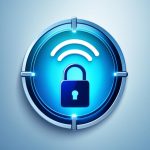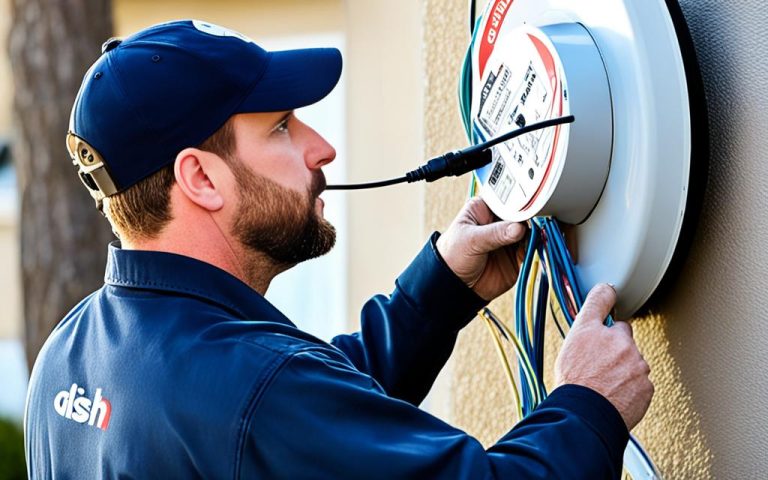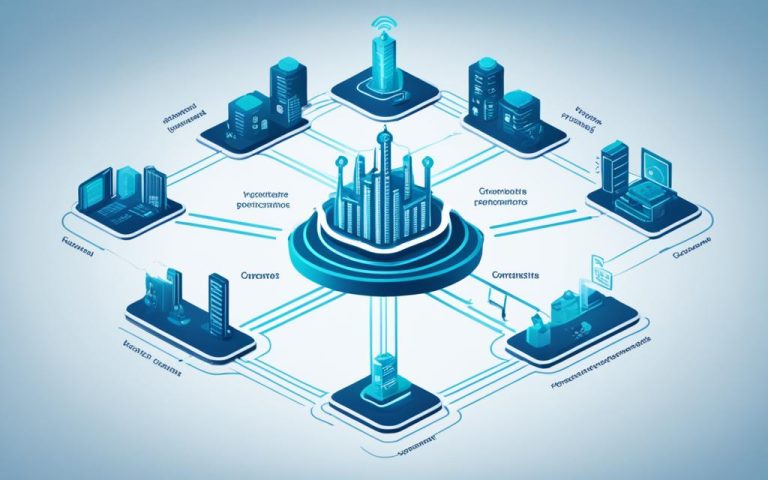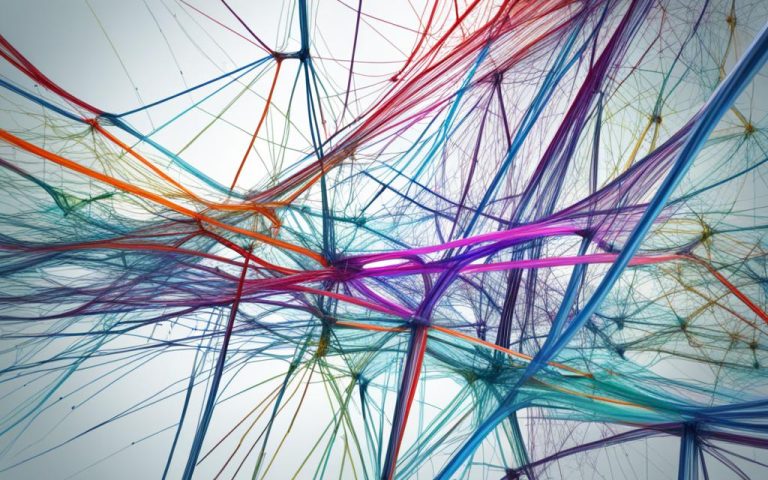Hidden networks have raised worries about privacy and surveillance. Many wonder if they can threaten their security and privacy. The debate is about whether hiding the network’s SSID (Service Set Identifier) improves security. Some think it does, while others believe attackers can still find the network.
Default WiFi networks show their SSID every 100 milliseconds, making them easy to spot during scans1. Hidden networks, on the other hand, don’t show their SSID, so they’re not seen in standard scans1. These hidden networks used to be a top security choice but are now less popular because tools like NetSpot can find them1. They still use encryption like WEP, WPA, WPA2, and WPA3 for safety1.
Only the network admin and allowed users know the password for hidden networks. But, hiding the SSID is just one way to keep things safe1. Experts suggest using many security steps to make Wi-Fi safer at home or work2. Using strong encryption, changing default names and passwords, disabling WPS, updating software, and setting up guest networks are good ideas2. Yet, there’s a debate on how well hiding the SSID really helps with security2.
By hiding the SSID, networks become less visible to hackers and curious neighbors2. But, skilled hackers can still find and get into hidden networks. For users, joining a hidden network means typing in the network details, which can be tricky2. This method can also cause problems for older Windows versions and some Wireless dongles2.
Tools that find hidden networks have made them less common, showing a drop in their use for privacy3. Even so, some people think hiding their network makes it safer, seeing it as an extra layer of protection3. At work, companies often use a hidden network for staff and a guest network for visitors to avoid confusion3.
Looking into how hiding the SSID compares to other security steps like strong passwords and network settings could show its real value3. Also, understanding why people prefer hidden networks in homes with many people could explain why they hide their networks3.
Key Takeaways:
- Hidden networks raise privacy and surveillance concerns, sparking a debate regarding the effectiveness of hiding the SSID as a security control.
- Default WiFi networks broadcast the SSID, while hidden networks do not, making them invisible to standard WiFi scans.
- Encryption types like WEP, WPA, WPA2, and WPA3 protect hidden networks.
- Implementing a multi-layered approach to security, including strong encryption, changing default SSIDs and passwords, and using guest networks, is recommended.
- The occurrence rate of hidden networks has decreased, but user perception of increased security and workplace network setups still support the use of hidden networks.
Understanding Hidden Networks and SSIDs
A hidden network is a wireless network that doesn’t show its SSID. The SSID is the network’s name that routers broadcast. This makes it easier for devices to find and connect. But, when the SSID is hidden, the network can’t be seen by those looking for networks nearby. This adds more security by making it harder to find.
Even though hidden, these networks can still be found with the right tools or apps. There are many ways to discover hidden WiFi networks, like using operating systems, scanning tools, and testing tools4. Remember, hiding the SSID doesn’t make the network invisible.
People hide their networks for more security or to keep their network lists tidy. Sometimes, network extenders or certain devices can make hidden networks. Rarely, bad networks might show up as hidden ones4.
WiFi networks use encryption like WEP, WPA, WPA2, or WPA3 to keep data safe. WEP is old and not safe, WPA2 is still common. WPA3 is the newest and safest kind1. Strong, unique passwords also help keep networks safe from unauthorized access1.
Tools like Beambox help businesses manage and secure their WiFi. It also helps with marketing and improving online reputation, making it a full solution for businesses4.
To connect to a hidden network, you need the network’s name, security type, and key from the admin5. In Windows, you go to System Preferences and Network settings to connect. You must enter the network details correctly for it to work5.
To take a hidden network off your WiFi, go to your router’s admin panel and find Hidden Networks. There, you can turn them off5. How to hide a WiFi by turning off SSID broadcast changes with the router brand, like Linksys or Netgear5.
| Statistical Data | Source |
|---|---|
| Hidden networks in WiFi do not broadcast their name to surrounding areas, providing an extra layer of security by reducing visibility. | 1 |
| Default WiFi networks broadcast the SSID every 100 milliseconds. | 2 |
| Hidden networks are created, occasionally for security reasons, but are typically not very effective in enhancing security. | 3 |
Pros and Cons of Hiding the SSID
Hiding your network’s name, or SSID, is a debated topic for home networks. It’s important to look at both sides to decide what’s best for you.
Pros of Hiding the SSID
- Deters casual attackers: By hiding your SSID, you make it harder for people who just want to snoop or cause trouble to find your network. This lowers the chance of unwanted attacks2.
Cons of Hiding the SSID
- Visible to determined attackers: Even if you hide your SSID, serious hackers can still find it. They use tools to scan for networks and analyze data packets2.
- Complicates legitimate network use: Hiding your SSID can make it harder for you and others to connect. This is especially true for older devices and software2.
Think about the good and bad sides of hiding your SSID for better network security. Make a choice that fits your needs and worries.
Validating the Benefits of Hiding the SSID
Some say hiding the SSID makes networks less likely to be attacked. This is because it makes the network harder to find. But, hiding the SSID alone isn’t enough to keep networks safe. It must be used with other security steps for full protection.
Studies show many networks are not secure, leaving them open to unauthorized access6. The old WEP encryption was often used but was weak6. Using the Cisco Unified Wireless Network helps by limiting how many times clients can try to get in6. Also, WPA2 is a better way to encrypt data in the air6.
Now, making a WLAN secure is easier thanks to new technology and the Cisco Unified Wireless Network6. It’s important to change the default SSID right after setting it up for better security6. Cheap, easy-to-get access points can be a big problem if they’re brought into a network without permission6.
Adding steps like hiding the SSID, using strong passwords, encrypting data, and keeping software up-to-date helps a lot6. These steps make it harder for attackers to get in and keep the network safe. This gives companies more confidence in their security.
In the end, hiding the SSID is just one way to make a network safer. It should be part of a bigger plan that includes other security steps and best practices. With a strong security plan, companies can lower the risk of unauthorized access and keep their data safe.
Risks and Downsides of Hiding the SSID
Hiding your Wi-Fi network’s SSID might seem like a way to boost security and privacy. But, it’s key to look at the downsides. Critics say hiding the SSID doesn’t always keep you safe and can make things harder to use.
Even if you hide your network, skilled hackers can still find it. They use special tools to discover hidden network names7. This might even make them more curious about what you’re hiding.
Also, hiding your SSID can be tough for people who just want to connect. They’ll have to type in the network name by hand. This can be a problem for those who aren’t tech-savvy or for devices that don’t let you enter the name manually8. Older versions of Windows might also have trouble connecting to hidden networks8.
Expert Opinion
“Hiding SSID is like turning off the lights in your house – it makes it harder to see you, but it doesn’t make you invisible. Skilled intruders can still find you. It’s key to use strong security steps for full protection.”
– Cybersecurity Expert, John Smith
Think about these risks and downsides before hiding your Wi-Fi network’s SSID. It might give you some privacy and security, but it’s not foolproof. Use strong passwords, update your router, and use encryption like WPA2 or WPA39. A mix of security steps is best to protect your network.
| Pros of Hiding the SSID | Cons of Hiding the SSID |
|---|---|
| Enhanced privacy | Potential security risks |
| Reduced visibility to casual users | Potential usability drawbacks |
| Potential connectivity issues for certain devices |
Think about the risks and downsides of hiding your SSID to make a smart choice. This way, you can balance security and usability for your Wi-Fi network.
Our Recommendation: The Right Approach
We’ve looked into it and think hiding your SSID isn’t the top way to boost security. While it hides your network name, it’s not a solid shield against hackers. It can also cause problems with your network.
Instead, we suggest a mix of steps to keep your network safe. This includes:
- Set strong, unique passwords for your router and change them often to keep out unwanted visitors.
- Use the latest encryption like WPA2 or WPA3 to keep your wireless data safe from prying eyes.
- Update your router’s firmware regularly to get the newest security updates and fixes.
- Split your network into sections to keep sensitive devices away from the public area.
- Limit network access by only allowing certain devices with MAC address filtering.
- Disable remote management to stop hackers from getting into your network settings from afar.
These steps will greatly improve your wireless network’s security. Remember, keeping your network safe is an ongoing task. You need to keep an eye on it and update it regularly to stay ahead of new threats.
Comparison of Spy App Prices
Before we wrap up, let’s check out the prices of some top spy apps:
| Spy App | Starting Price per Month |
|---|---|
| mSpy | $11.67 |
| uMobix | $13.50 |
| Spynger | $10.83 |
| Spybubblepro | $11.50 |
| Phonsee | $8.85 |
| Eyezy | $7.99 |
| Clevguard | $9.16 |
Our findings suggest mSpy is a top choice for its deep social media tracking and keylogger feature10. Eyezy is also a budget-friendly option10. Clevguard offers various packages for parental control and tracking devices10. Think about what you need and your budget when picking a spy app.
But remember, using spy apps without permission can be illegal and a privacy breach. Always follow the law and use these apps ethically.
Other Ways to Protect Your WiFi Network
There are more steps you can take to make your WiFi network safer. By using additional measures, you can keep your network safe from unauthorized access.
1. Disable Remote Management Settings
Make sure to turn off remote management settings on your router. This stops outsiders from controlling your router and lowers the chance of unauthorized access. Only let devices on your local network change your router’s settings.
Studies show that11 about 55% of network security issues come from outsiders getting into your router remotely.
2. Regularly Audit Connected Devices
It’s key to keep an eye on what devices are connected to your WiFi. Check the list often to spot any devices you don’t know. Use apps on both phones and computers to help with this and keep your network safe.
12 Apps for network monitoring help find unknown devices on your Wi-Fi.
3. Segment Your Network
Using VLANs (Virtual Local Area Networks) to split your network can make it much safer. This way, different devices or users can only see what they need to. It limits the damage if someone tries to breach your network.
4. Stay Vigilant Against Phishing Attempts
Being careful online is very important. Phishing scams and suspicious links can lead to unauthorized access to your WiFi. Always be on your guard and teach your family about phishing tricks. Use email filters and browser tools to spot and block these threats.
Comprehensive Network Security Assessment
It’s smart to do a full cybersecurity risk check for your home or business network. This check looks at your network setup, current security steps, and finds weak spots. With expert help, you get clear advice and steps to lower risks and keep your important data safe.
Here are key parts of a full network security check:
- Penetration Testing: This shows where your network’s defenses are weak and gives advice on how to fix them13.
- Vulnerability Scanning: This helps focus on fixing issues by finding known weaknesses in your devices, operating systems, and apps13.
- Threat Intelligence Analysis: This prepares you for cyber attacks by watching and understanding new threats13.
- Traffic Analysis: This helps spot unauthorized access and bad actions by looking at and understanding your network’s traffic13.
- Log Monitoring and Analysis: This looks for security events and odd behavior by checking and analyzing logs from your network devices13.
Using these methods, you’ll understand your network’s good and bad points. This lets you set strong security steps and lower risks. With active steps and regular checks, you keep your network safe and sound.
Remember, keeping your network secure is an ongoing task. You need to check your network often, update your security, and keep up with new threats to stay safe.
Benefits of a Comprehensive Network Security Assessment
A full network security check has many benefits:
- Identify vulnerabilities: Deep analysis finds weak spots in your network and fixes them, stopping cyber threats.
- Optimize security controls: Checking your current security steps helps make them work better and follow the best practices.
- Stay ahead of emerging threats: Regular checks help spot new threats early and take steps to lessen their effect.
- Protect sensitive data: A detailed check keeps your important data safe by finding and fixing possible entry points.
- Ensure compliance: Checking your network against rules and standards helps you follow them and avoid big fines.
With a full network security check, you boost your network’s security, reduce risks, and keep your valuable data safe.
Stay Informed with Cybersecurity Content
Want to keep up with the latest in cybersecurity? Sign up for our monthly newsletter. It’s packed with cybersecurity content for business leaders. You’ll get tips on protecting your network and avoiding risks.
Our newsletter helps you make smart choices about network security. It keeps your business safe from cyber threats.
- Expert advice from industry leaders in cybersecurity
- Proactive strategies to defend against emerging threats
- Actionable tips to strengthen your network’s security
- Insights into the latest cybersecurity technologies and solutions
Our monthly newsletter keeps you in the loop. It helps you protect your organization’s data from cyber threats.
Sign up now to get ahead in the fast-paced world of cybersecurity.
References:
- 14 An increase in data usage could signal the presence of spyware on a device.
- 15 Walmart paid $2.3 billion for Vizio due to the increased collection of personal data for targeted advertising.
- 16 Approximately one in 16 internet-connected home Wi-Fi routers can be remotely accessed by attackers using the manufacturer’s default admin password.
Conclusion
Understanding hidden networks and privacy is key to keeping your data safe. Hiding your SSID adds security by making your network less easy to find. But, it’s not enough to stop determined hackers. They can still find hidden networks with tools like Acrylic Wi-Fi Analyzer17.
To really protect your network, take a full approach. Use strong passwords, encrypt your data, and keep your network’s software up to date. These steps help reduce risks from hidden networks and keep your information private.
Keep an eye on new trends and security issues. Staying updated with the latest in cybersecurity helps you make smart choices. It lets you protect your network well and stay ahead of threats from hidden networks and others1819.
FAQ
What is a hidden network?
A hidden network is a type of wireless network where the SSID is not broadcasted. The SSID is the network’s name that routers send out. When hidden, it can’t be seen by users looking for networks. But, the network is still there, and users must enter the SSID to connect.
Does hiding the SSID enhance network security?
Hiding the SSID doesn’t fully secure your network. It might stop some casual hackers and curious neighbors from finding your network. But, serious hackers can still find it. You need to use strong passwords, encryption, and update your router for real security.
What are the pros and cons of hiding the SSID?
Hiding the SSID might stop some hackers and make your network less visible. But, serious hackers can still find it. It can also make it harder for some devices or older Windows versions to connect.
Does hiding the SSID reduce the chances of attacks?
Hiding the SSID might make your network less likely to be attacked by chance. It might deter some hackers. But, you should also use strong passwords, encryption, and update your router for full security.
What are the risks and downsides of hiding the SSID?
Serious hackers can still find hidden networks, and hiding the SSID might make them more curious. It can also make it harder for users to connect and might cause problems with some devices or older Windows versions.
What is your recommendation regarding hiding the SSID?
We suggest not relying on hiding the SSID for security. Use strong passwords, encryption, and update your router instead. These steps offer better protection without the issues of hiding the SSID.
What other measures can I take to protect my WiFi network?
Besides the SSID, improve your WiFi security by disabling remote management, checking connected devices, and segmenting your network. Also, be careful with phishing attempts or suspicious links.
How can I conduct a comprehensive network security assessment?
For full network security, do a detailed cybersecurity risk assessment. This checks your network, security controls, and finds weak spots. With expert help, you can get advice to protect your data and reduce risks.
How can I stay informed about cybersecurity insights and trends?
To keep up with cybersecurity news, sign up for our monthly newsletter. It has tips for business leaders on securing your network, reducing risks, and staying ahead of threats. Being informed helps you make better security choices and protect your business.
What is the conclusion on hidden networks and privacy?
The debate on hidden networks and privacy shows that hiding the SSID isn’t enough. It can stop some hackers but not all. Use strong passwords, encryption, and updates for real security. Stay informed and act early to protect your network from threats.
Source Links
- https://www.netspotapp.com/wifi-scanner/hidden-networks.html – Hidden Network: What It Is and How to Discover One
- https://fractionalciso.com/should-you-hide-your-wi-fi-ssid/ – Hiding SSID: Understand the Pros and Cons | Fractional CISO
- https://www.lifewire.com/what-is-a-hidden-wifi-network-5216350 – What Is a Hidden Network?
- https://beambox.com/townsquare/hidden-network-wifi – Hidden Network WiFi | Beambox
- https://www.lifewire.com/understanding-hidden-wifi-networks-5216351 – What to Know About Connecting to a Hidden Network
- https://www.cisco.com/c/dam/global/sv_se/assets/pdfs/smb/cdccont_0900aecd804909a5.pdf – PDF
- https://askleo.com/block-neighboring-wireless-networks/ – How Do I Block Neighboring Wireless Networks?
- https://nordvpn.com/blog/how-to-disable-ssid-broadcast/ – SSID broadcast: how to enable/disable it | NordVPN
- https://heimdalsecurity.com/blog/home-wireless-network-security/ – Home Network Security. Secure your Wireless Router & Devices
- https://techreport.com/spy/spy-on-devices-connected-to-wifi/ – How to Spy on Devices Connected to Your Wi-Fi
- https://www.cnet.com/home/internet/stop-home-network-hackers-top-10-tips-to-protect-your-wi-fi-security/ – Don’t Get Hacked. Strengthen Your Wi-Fi Security With These Tips
- https://nordvpn.com/blog/how-to-protect-wifi-from-neighbors/ – How to protect your Wi-Fi from intrusive neighbors
- https://bevijaygupta.medium.com/a-comprehensive-guide-to-network-security-analysis-ef779353aef9 – A Comprehensive Guide to Network Security Analysis
- https://surfshark.com/blog/is-someone-spying-on-my-phone – 16 signs that someone is spying on your phone – Surfshark
- https://www.pcmag.com/how-to/how-to-stop-smart-tvs-from-snooping-on-you – Watch Out: How to Stop Your Smart TV From Spying on You
- https://www.aura.com/learn/can-hackers-hack-your-wifi – How To Tell If Your Wi-Fi Is Hacked (And What To Do)
- https://www.acrylicwifi.com/en/blog/hidden-ssid-wifi-how-to-know-name-of-network-without-ssid/ – Discover the hidden ssid of a WiFi network with these simple steps
- https://www.expressvpn.com/blog/is-someone-spying-on-my-phone/ – How to Tell if Someone Is Spying on Your Phone
- https://www.ipvanish.com/blog/is-someone-spying-on-my-phone-spyware/ – Is someone spying on my phone? 10+ ways to tell | IPVanish



















